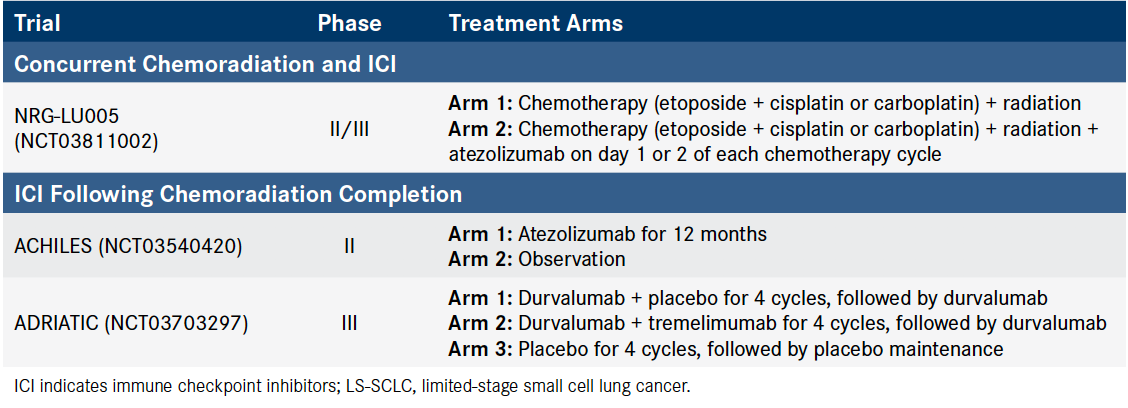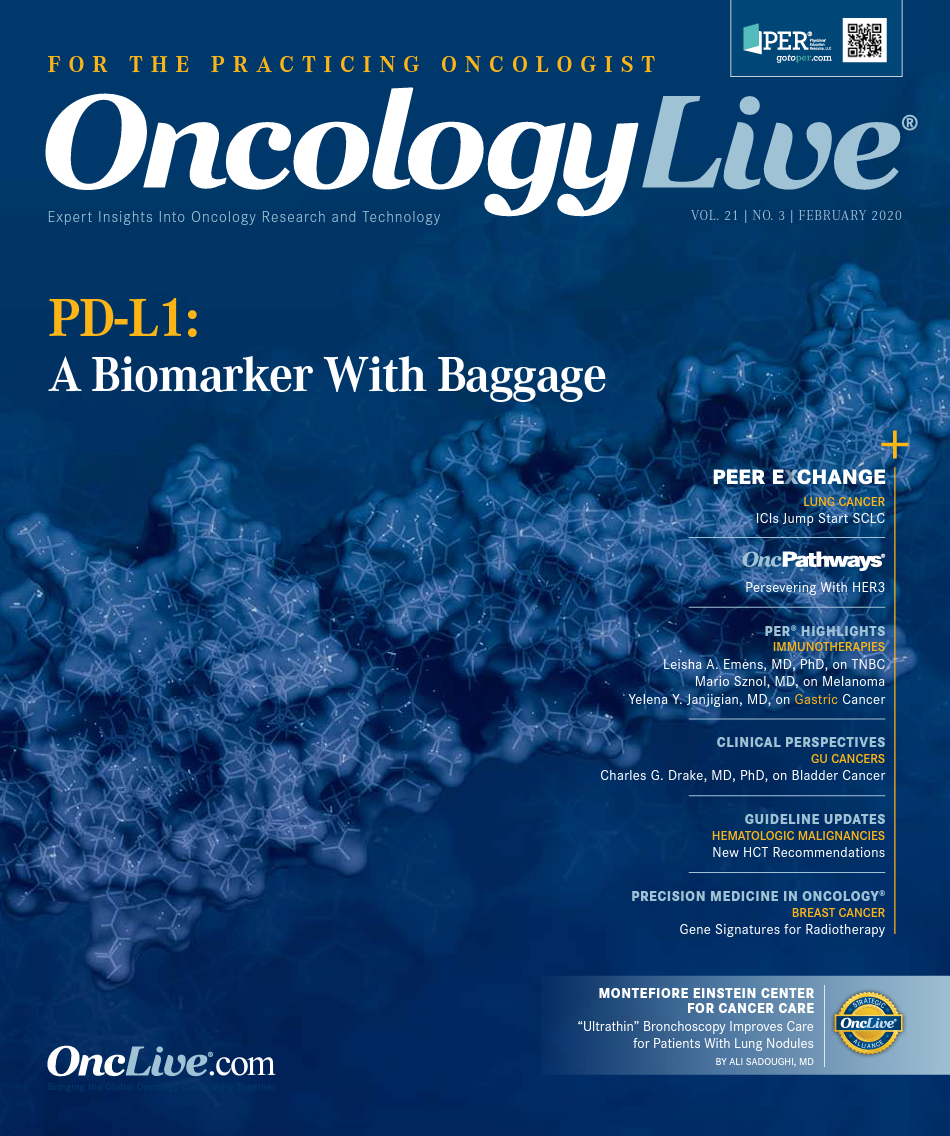Immunotherapy Opens Doors in Small Cell Lung Cancer
Immune checkpoint inhibitors have yielded modest improvement in small cell lung cancer (SCLC), but have already reshaped the management of this tumor type and helped open the door to the exploration of other, potentially more effective treatment approaches, according to a panel of thoracic oncology experts who discussed the treatment horizon for SCLC in a recent OncLive Peer Exchange® panel.
Naiyer A. Rizvi, MD

Naiyer A. Rizvi, MD
Immune checkpoint inhibitors (ICIs) have yielded modest improvement in small cell lung cancer (SCLC), but have already reshaped the management of this tumor type and helped open the door to the exploration of other, potentially more effective treatment approaches, according to a panel of thoracic oncology experts who discussed the treatment horizon for SCLC in a recent OncLive Peer Exchange® panel.
“Unlike where we were a decade ago, where this was a complete desert and nobody was interested, SCLC is now becoming more interesting to both investigators as well as pharmaceutical sponsors, said panelist Taofeek K. Owonikoko, MD, PhD, MSCR, a prolific investigator in SCLC, a highly aggressive disease associated with a heavy symptomatic burden and a dismal 5-year survival rate, ranging from 2.8% for extensive-stage (ES) disease to <28% for limited-stage (LS) disease.1
The OncLive Peer Exchange® panel discussed immunotherapy approaches across the SCLC spectrum. They discussed the practice- changing IMpower133 trial (NCT02763579), which led to the first ICI being approved in the firstline setting, as well as the CASPIAN trial (NCT03043872), which is lending further support to using ICI therapy up front.2,3 They also discussed several ICI therapies approved in the relapsed/refractory ES setting and what the results of 2 recent negative trials might mean for clinical care. Because immunotherapy benefits have been modest across the board, other novel agents are under active investigation, and the panelists discussed a few such emerging therapies as well as ongoing clinical trials that are poised to further shape SCLC management. “I’m hopeful that all these strategies will lead us forward and eventually result in new treatment options for our patients,” Owonikoko said.
IMpower133 and CASPIAN
Based on the results of the phase III IMpower133 trial, the panelists agreed that, barring any contraindications, all patients with ES-SCLC should receive chemoimmunotherapy in the first line. IMpower133 randomly assigned 403 treatment-naïve patients 1:1 to carboplatin and etoposide plus atezolizumab (Tecentriq; n = 201) or placebo (n = 202) for 4 cycles, followed by atezolizumab or placebo maintenance, depending on their previous assignment.2 All patients were treated until they experienced unacceptable toxicity or disease progression or showed no additional clinical benefit. The primary end points were investigator-assessed progression- free survival and overall survival (OS) in the intention-totreat population.
At a median follow-up of 13.9 months, the median OS was 12.3 months in the atezolizumab group and 10.3 months in the placebo group (HR, 0.70; 95% CI, 0.54-0.91; P = .0069).2 “This is truly a practice-changing trial, ” panelist Jamie E. Chaft, MD, said. ”The improvement in overall survival of about 2 months, although seemingly small, is quite large for this disease.” Based on the IMpower133 data, on March 18, 2019, the FDA approved atezolizumab in combination with carboplatin and etoposide as a first-line treatment for adult patients with ES-SCLC.4
The panelists discussed the value of adding consolidation chest radiotherapy (RT), another mainstay of SCLC treatment, to the IMpower133 chemoimmunotherapy regimen. Historically, patients receiving chemoradiation have shown high responsiveness initially, but often have early recurrence.1 “[Based on] what we know about neoantigen release and some synergy with immunotherapy, maybe we should be trying to incorporate [RT] into our paradigm,” moderator Naiyer A. Rizvi, MD, said, adding that he has not observed chest RT to cause more pneumonitis or other complications when combined with immunotherapy in other settings.
“I think we really have to explore chest consolidation for some of these patients for whom we worry about recurrence with SVC [superior vena cava] syndrome with bulky disease in the chest that comes very rapidly,” panelist Ticiana A. Leal, MD, said. She and the other panelists agreed this approach merits investigation but cautioned against using it in clinical practice without direct data to guide its use, which they said could lead to more harm than good.
Although data have thus far been reported only for 2 of the 3 treatment arms in the CASPIAN trial, the panelists found the results reassuring because they mirrored those observed in IMpower133. CASPIAN randomly assigned previously untreated patients with ES-SCLC 1:1:1 to etoposide-platinum plus durvalumab (Imfinzi), etoposide- platinum plus durvalumab and tremelimumab, or etoposide-platinum alone.3 Patients in the immunotherapy arms received up to 4 cycles of chemoimmunotherapy followed by durvalumab maintenance until disease progression, whereas those in the chemotherapy arm received up to 6 cycles of etoposide-platinum and optional prophylactic cranial irradiation. Data from the planned interim analysis have been reported for durvalumab plus etoposide-platinum versus etoposide-platinum alone.3
At the interim analysis, the chemoimmunotherapy combination significantly improved OS compared with chemotherapy, with a median OS of 13.0 months versus 10.3 months, respectively (HR, 0.73; 95% CI, 0.59-0.91; P = .0047). At 18 months, 33.9% of patients in the chemoimmunotherapy arm were alive versus 24.7% of those in the chemotherapy arm.
“It’s reassuring that we’re seeing a very well-designed study that is once again confirming that, for a subset of patients with small-cell lung cancer, there is a benefit of adding immunotherapy to chemotherapy,” Leal said.
The panelists proceeded to discuss how first-line treatment for SCLC might change if durvalumab is ultimately approved by the FDA. One key discussion point was the different dosing schedules in the CASPIAN and IMpower133 trials. CASPIAN used 4-week dosing, whereas the approved IMpower133 regimen uses 3-week dosing. Because SCLC is such an aggressive disease, some panelists said waiting 4 weeks between dosing to see their patients is too long. “Most [patients who have aggressive or symptomatic disease] need to be seen more frequently, and 3 weeks is kind of the outer limit of that frequency that I’m comfortable with,” Chaft said. She acknowledged, however, that the 4-week dosing schedule may be beneficial for patients who live in rural communities or have difficulty traveling due to challenges with time, effort, or cost. In contrast, Owonikoko said he was not concerned about the 4-week dosing schedule. “As long as we have the data to show there are comparable PK [pharmacokinetics] characteristics between the every-3-week and every-4-week schedule, I would be comfortable doing either,” he said. Of note, atezolizumab is approved as frontline maintenance in ES-SCLC at multiple dosing regimens, including every 2 weeks, every 3 weeks, and every 4 weeks.
ICIs in the Relapsed and Maintenance Settings
On August 16, 2018, based on data from the CheckMate-032 trial (NCT01928394), the FDA granted nivolumab (Opdivo) accelerated approval as a third-line treatment for metastatic SCLC with progression after platinum-based chemotherapy and at least 1 other line of therapy.5 Less than 1 year later, on June 17, 2019, based on data from the KEYNOTE-158 (NCT02628067) and KEYNOTE-028 (NCT02054806) trials, the FDA granted pembrolizumab (Keytruda) accelerated approval for patients with metastatic SCLC with disease progression on or after platinum-based chemotherapy and at least 1 other line of therapy.6 Among these positive trials leading to ICI approvals, however, there have been 2 negative randomized phase III immunotherapy trials: CheckMate 331, which compared nivolumab with topotecan in patients with relapsed SCLC after first-line platinum-based chemotherapy, and CheckMate451, which compared nivolumab plus ipilimumab, nivolumab monotherapy, and placebo as maintenance therapies after first-line platinum-based chemotherapy.7,8 The panelists discussed these negative studies and whether their findings cast doubt on the results observed in the positive trials.
“When we see these patients in clinic, and we’ve all seen them, we know that [nivolumab] actually does work for patients. It’s just that knowing who those patients are is key, so the [negative trials have] not dissuaded me from the use of nivolumab or nivolumab-ipilimumab in appropriate patients,” Owonikoko said. He added that he uses nivolumab in the third line, as per the FDA indication, and uses a cytotoxic agent in the second line, but avoids topotecan because of its toxicity.
Regarding the CheckMate451 trial, in which Owonikoko participated as an investigator, a major challenge was the toxicity of the regimen, which made it difficult for patients to stay on the treatment. He attributes the study’s negative findings to the short treatment duration. “The median number of cycles delivered in [the nivolumab-ipilimumab] arm of the study was only 1 cycle,” he said. “Because of the design, although there was a trend toward improvement with nivolumab [monotherapy], you could not test that statistically because the primary arm of the study was the nivolumab- ipilimumab arm, and it was negative,” Owonikoko explained.
Emerging Therapies
Although chemoimmunotherapy has led to the first increase in OS in decades, the benefits have been modest and additional approaches are desperately needed. The panelists discussed several promising strategies under investigation. Among these, lurbinectedin, is furthest along in development, and a new drug application was recently submitted to the FDA for accelerated approval of this agent as a second-line treatment in patients with SCLC.9
Table 1. Outcomes With Lurbinectedin Monotherapy in Chemosensitive Versus Chemoresistant SCLC10 (Click to Enlarge)

The new drug application was submitted to the FDA based on data from a phase II basket trial (NCT02454972) that assessed the safety and efficacy of lurbinectedin in several cancer types, including SCLC.10 In the study, lurbinectedin had an overall response rate of 35.2% (95% CI, 26.2%- 45.2%), disease control rate at 8 weeks of 64.8%, and a median OS of 10.8 months (95% CI, 6.5-12.2) as a second-line treatment for SCLC. When the efficacy data were examined based on chemotherapy sensitivity, those with chemosensitive disease were found to have better outcomes than those with resistant disease (Table 1); patients were classified as having chemoresistant disease if their chemotherapy-free interval was <90 days.
“Regardless of whether you are chemotherapy sensitive or refractory, or chemotherapy resistant, there is something to be said for this agent in relapsed small cell,” Owonikoko said, adding that although the benefit is modest, it is better than what is currently available.
Another class of agents the panelists discussed are delta-like ligand 3 (DLL3)—targeting therapies. One such agent, rovalpituzumab tesirine (Rova-T), was assessed in the phase II TRINITY study as a third-line treatment for patients with DLL3-expressing SCLC.11 Although the trial showed Rova-T to have some clinical activity, there was no survival advantage and the agent was associated with significant toxicity, with grade 3 to 5 adverse effects observed in 53% of patients.11 Rova-T also failed to show survival benefit in the phase III MERU trial, where it was assessed as a first-line maintenance therapy for patients with advanced SCLC.12 Subsequently, the drug’s research and development program was discontinued.12 Despite the setbacks with Rova-T, Chaft said that DLL3 is still an exciting target.
“I think we’re still enthusiastic about DLL3. It’s expressed particularly in certain subsets of SCLC and should be a promising target for the future within other immune-directed approaches by specific antibodies, CAR T-cell therapy, and things like that,” she said.
Table 2. Ongoing Clinical Trials Assessing ICIs in LS-SCLC13-15 (Click to Enlarge)

In their concluding remarks, the panelists emphasized the importance of research to identify patient subsets in SCLC. “We still don’t understand a lot of the biology of small cell,” Rizvi said. However, he said that efforts are underway to more thoroughly analyze tissue specimens, aided by technology that has improved to enable immune characterization. Findings from these assessments will be crucial to direct future studies and improve treatment approaches with ICIs and other agents across the SCLC spectrum.
The panelists proceeded to discuss several trials being conducted for patients with LS-SCLC. Because these patients often do well with chemotherapy and radiation, the role of immunotherapy in these patients is less clear. “I think the real question here is going to be whether immunotherapy should follow chemoradiation, or if we should be looking at it with chemoradiation…but we should be investigating everything in this small but potentially curable patient population,” Chaft said. The panelists noted that several ongoing clinical trials are still enrolling patients with LS-SCLC and are poised to help answer that question (Table 2).13-15 Owonikoko expects these trials to start yielding answers over the next few years.
“[Lurbinectedin] seems to be particularly effective in patients with chemosensitive disease, and the mechanism of action is rational for small cell lung disease, which we now know to be a transcriptionally addicted tumor. This is an agent that works by inhibiting RNA polymerase function and therefore preventing transcription,” Owonikoko explained.




